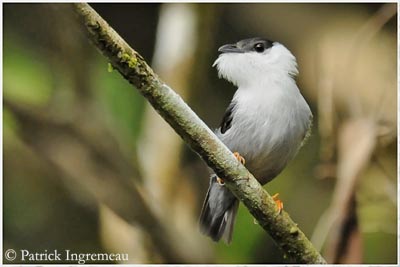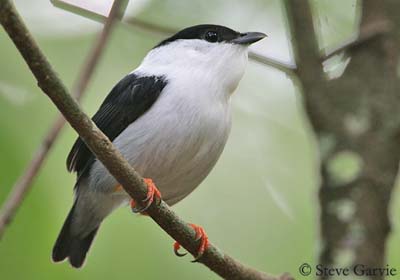
White-bearded Manakin
Manacus manacus
Passeriforme Order – Pipridae Family
BIOMETRICS:
Length: 10-11 cm
Weight: 16,5-18 g
DESCRIPTION:
White-bearded Manakin, as other manakins’ species, is a small compact bird. Its courtship displays are spectacular and occur at communal leks.
FLIGHT:
White-bearded Manakin performs rapid and complex flight displays. When in flight, this bird produces a kind of whirring noise, as a grasshopper.
REPRODUCTION:
Breeding season varies according to the region.
The white-bearded Manakin male does not take part in nesting duties.
The nest is a small shallow cup built between horizontal twigs, and secured with spider webs. It is usually placed low in vegetation, from 50 cm to 1, 50 metre above the ground. It is a woven cup, made with rootlets and dead leaves, and the interior is lined with fine and soft materials. The nest-site is often near water.
Female usually lays two eggs. She incubates during 18 to 19 days, spending long moments on the nest, with brief foraging flights.
Chicks are fed mainly with insects, and they fledge about two weeks after hatching.
DIET:
White-bearded Manakin feeds mainly on small fruits. It also consumes insects such as beetles, flies and flying termites. It also takes spiders.
PROTECTION / THREATS / STATUS:
White-bearded Manakin is common in most parts of its range. The species is not threatened at this moment.
Fr: Manakin casse-noisette
All : Weißbrustpipra
Esp : Saltarín Barbiblanco
Ital : Manachino barbabianca
Nd : Bonte Manakin
Russe : Белобородый короткокрылый манакин
Photographs by Steve Garvie
His website : RAINBIRDER Photo galleries
Photograph by Patrick Ingremeau
His website :
TAMANDUA
Text by Nicole Bouglouan
Sources :
HANDBOOK OF THE BIRDS OF THE WORLD VOL 9 by Josep del Hoyo - Andrew Elliot - David Christie - Lynx Edicions - ISBN: 8487334695
A GUIDE TO THE BIRDS OF COLOMBIA by Steven L. Hilty and William L. Brown
Princeton University Press – ISBN 069108372X
Wikipedia (Wikipedia, The Free Encyclopedia)

Adult male has black and white plumage.
Crown, back, wings and tail are black. Rump and uppertail coverts are rather grey.
On the underparts, chin, throat and breast are white. Belly, flanks, vent and undertail coverts are pale grey. Undertail feathers are black.
The throat shows elongated feathers which play an important role in courtship displays.
On the head, lores, forehead and crown are black. Cheeks and neck collar are white.
Bill is blackish, with paler lower mandible. Eyes are dark brown. Legs and feet are orange-red.
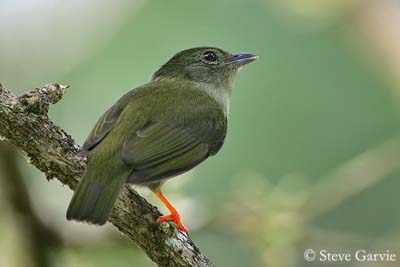
Female is very different with olive-green plumage on upperparts. Underparts are duller, rather greyish-olive on throat and belly. Breast is more olive-green.
Juvenile is similar to female. Immature male has full adult plumage at one year.
We find several subspecies which vary in size and sometimes in colour extension.
M.m. abditivus, with stiff and longer throat feathers.
M.m. flaveolus with yellowish tinge in throat and collar.
M.m. bangsi is smaller with grey belly and narrower collar.
M.m. leucochlamys with more white in mantle and white belly.
M.m. maximus is similar in plumage but larger, with longer throat and mantle feathers.
M.m. interior with paler grey rump and lower belly and vent.
M.m. trinitatis is larger, with broader white collar.
M.m. umbrosus with darker grey areas.
M.m. manacus is very similar.
M.m. expectatus is much smaller.
M.m. subpurus with darker grey rump and variation of grey on underparts.
M.m. purus with less black on upperparts.
M.m. longibarbatus with longer throat feathers and some variations in colour extensions.
M.m. purissimus with shorter throat feathers and longer wings.
M.m. gutturosus is darker grey below.
VOICE: SOUNDS BY XENO-CANTO
White-bearded Manakin usual call is a slightly trilled “peerr” uttered at lek. During the displays, the male utters an excited “pee-you” and a high-pitched “chwee”.
As other manakins’ species, it produces snaps and other noises with the wings.
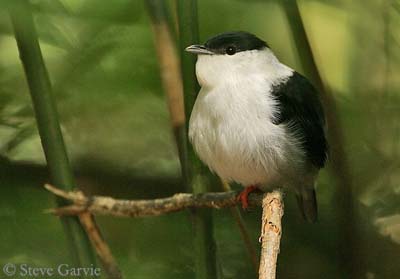
HABITAT:
White-bearded Manakin is locally common in gallery woodland and forest edges with dense undergrowth. It also frequents second growths. It is mainly seen below 800 to 1000 metres of elevation.
RANGE:
White-bearded Manakin is resident in tropical regions of South America. It is found in Colombia, Venezuela and Trinidad, and southwards in Bolivia and northern Argentina. There are two populations in separated ranges, one in the Pacific coast of Ecuador, and the other in eastern and south-eastern coasts of Brazil.
BEHAVIOUR:
White-bearded Manakin feeds mainly on small fruits and insects (mainly eaten by the young). Fruits are plucked while flying, or sometimes from a perch if the fruit is close enough. Insects are caught in flight in low branches. It usually forages alone.
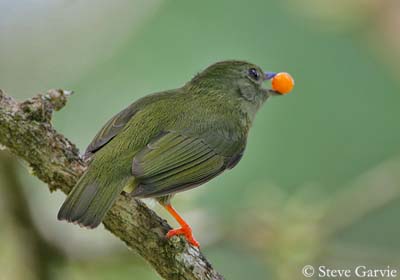
As other manakins’ species, the White-bearded Manakin performs elaborated and complex figures at leks, involving several males. The lek is the same year after year, and the male spends most of its time in its territory. Displays are more active after dawn and in the early afternoon.
White-bearded Manakin performs three distinct phases during the courtship displays, always with several males, sometimes up to 50 or more.
The first phase is the commonest. The males jump between vertical twigs situated around the lek. The bird is perched sideways on a vertical stem. At this moment, the long throat feathers are erected as a “beard” longer than the bill.
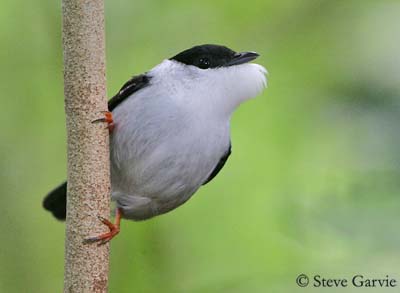
The bird leaps across to an opposite vertical perch. As it alights, it turns in the air in order to look at the place from which it came. This short flight produces the characteristic snap when the bird takes off.
White-bearded Manakin male repeats rapidly these movements to and fro between two perches. When several males perform these movements together, we only see jumping black and white silhouettes.
The second phase is performed occasionally and less common. After the series of jumps from perch to perch, one male remains on the mating perch, quivering, and with the head and the body pointed downwards. Then, it hops to the ground, turning in the air, lands with a strange grunting sound, and returns to higher place on the mating perch. Then, with rapid small steps, it comes down to the perch with flapping wings. This phase is pre-copulatory.
The third phase is often directed to a female approaching the lek. The male crouches while its head is retracted. It sways side to side and flaps the wings, producing the whirring sounds. The long throat feathers are fluffed forwards and upwards as the wings are raised and fanned.
The female which visits a lek for mating, usually joins the male in a dance of jumps between a stem and the mating perch, both birds crossing each other in the air. Then, the female remains on the mating perch. At this moment, the male performs the pre-copulatory display, ending in the “slide down” the perch onto female’s back.
